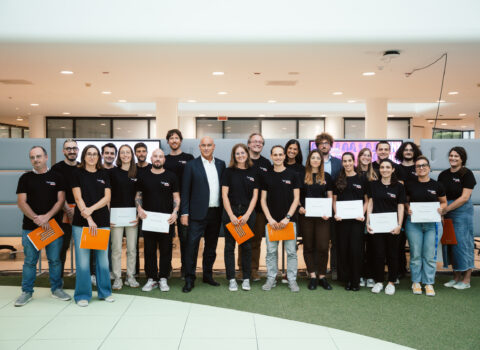
AI in Act-ion o Inaction?
From the AI Act to Apply AI: the EU between Industry, Research and Policies
On 8 October, the European Union presented two new strategies: Apply AI and AI in Science. The first aims to accelerate the adoption of artificial intelligence (AI) in industry, while the second is aimed at the academic and scientific world — a particularly relevant combination for Fondazione Bruno Kessler.
Almost simultaneously, on October 10, the Italian law on artificial intelligence (Law No. 132/2025) came into force — the first national regulatory framework on AI, aimed at ensuring the “correct, transparent and responsible” development of artificial intelligence and aligning with the AI Act.
After defining risks and requirements with the AI Act, the European Union now seems determined to respond to the warning of the Draghi Report and “do something.” The name Apply AI suggests just that: we have established the rules, now let’s start playing. These strategies should mark the transition from a regulatory phase to a practical implementation phase, indicating how the EU intends to use AI to innovate industry and research, as well as regulate it and ensure its safe and ethical use.
What the two strategies provide for
Apply AI is a strategy that aims to accelerate the adoption of AI in major European industries and the public sector, with pilot initiatives in sectors such as healthcare and pharmaceuticals, energy, mobility, industrial production, construction, agri-food, defense, communications, climate, and the cultural and creative sectors. It also includes cross-cutting interventions to help small and medium-sized enterprises (SMEs) adopt AI, train the workforce, and promote market confidence, as well as the creation of a unified governance mechanism with a European AI Observatory.
Among the planned initiatives are:
- Creation of advanced centers for diagnosis and screening in the health sector
- Development of intelligent models and agents dedicated to industrial production and pharmaceutical research.
- Strengthening of European hubs for digital innovation, with access to artificial intelligence “factories,” test facilities, and regulatory experimental spaces.
- Launch of an academy for artificial intelligence skills (AI Skills Academy).
- Mobilization of about one billion euros to finance pilot projects and digital infrastructures.
- Establishment of a governance system with the Apply AI Alliance that coordinates AI providers, industry, academia, and the public sector, and an observatory to monitor AI trends and impacts.
AI in Science, on the other hand, is the strategy aimed at the scientific and academic world and includes two pillars:
- Science for AI, to facilitate research on AI models
- AI for Science, to promote the use of AI in research across different fields.
Its core will be the creation of RAISE (Resource for AI Science in Europe), a virtual institute that will network resources and talents for AI in science. Through RAISE, researchers and startups will have dedicated access to future computing facilities for training AI models. In addition, Horizon Europe’s annual investment in AI is expected to double to over €3 billion
The framework is completed by the Data Union Strategy, expected by the end of October 2025, which promises to open up new sources of high-quality structured data shared at the European level. This data strategy aims to ensure that businesses, the public sector, and the scientific community have continuous access to large datasets useful for training algorithms.
Why it’s important
Having established how AI should be (reliable and human-centred), the EU now defines what to do to spread it: investments in sectoral programs, basic and applied research, shared data, and collaborations with companies and public administrations. The common thread is industry–research integration. The two joint strategies aim to promote an ecosystem where research, business, and the public sector work side by side.
Critical issues and open questions
The funds deployed, although significant, are likely to be insufficient. A billion euros to “transform” all sectors with AI is a limited figure that cannot compete with the resources deployed by U.S. big tech companies, on which the European AI supply chain also largely depends.
According to the AI Index Report 2025, in 2024 the United States recorded $109.1 billion in private investment in AI — about 5.6 times that of Europe and the United Kingdom (19.4 billion) and 12 times that of China ($9.3 billion).
A second issue is the regulatory complexity introduced by the AI Act, which could penalize smaller businesses. There is therefore a risk of excluding SMEs from the AI race, leaving only large companies able to afford the necessary regulatory compliance and investments, while startups and SMEs might give up developing AI solutions in Europe to avoid costs and regulatory uncertainty. This would conflict with the very objective of the Apply AI strategy, which instead aims to stimulate adoption among small and medium-sized enterprises.
Italy, with its Law 132/2025, is also trying to avoid this scenario by creating regulatory sandboxes — protected environments in which companies can experiment with new AI-based products or services — and by providing incentives to reduce burdens and facilitate the adoption of AI by SMEs, stimulating a local AI market. However, the challenge is European: without strong coordination and large-scale joint investments, individual EU states will hardly be able to compete alone with global powers.
Another critical issue concerns governance: the new EU plans still lack clear mechanisms to coordinate with national strategies and ensure rigorous monitoring of progress and evaluation of results.
Finally, the European document emphasizes skills and the so-called “AI literacy,” stressing that solid AI literacy should begin at the earliest levels of education and continue in the labor market through professional retraining (reskilling) and upskilling, with reference to the Digital Education Action Plan. It is crucial to accompany students and workers so they develop the necessary skills to remain competitive in the labor market and keep pace with a technology that is inexorably becoming part of daily life, as well as to attract and retain talent and researchers in the field of AI.
Europe, often criticized for slowness and over-regulation, now seems eager to press the accelerator: we hear about resources, integration of AI into production processes, computing centers, applied research, and data access. However, it has not yet geared up: funds are limited and without coordination the risk is of wasting efforts.
While criticisms of the EU’s slowness are well founded, as Luciano Floridi recalls in his book Ethics of Artificial Intelligence, “the rules do not concern the pace but the direction of innovation.” Going fast in the wrong direction would indeed be very costly. The challenge, therefore, remains complex, and Europe’s plan on paper is ambitious. Concrete and coordinated actions are needed: public–private alliances, access to data and computing capacity, sandboxes and guidelines that reduce costs for SMEs, as well as governance capable of measuring impacts and quickly reallocating resources. Press the accelerator — and steer well, together.




